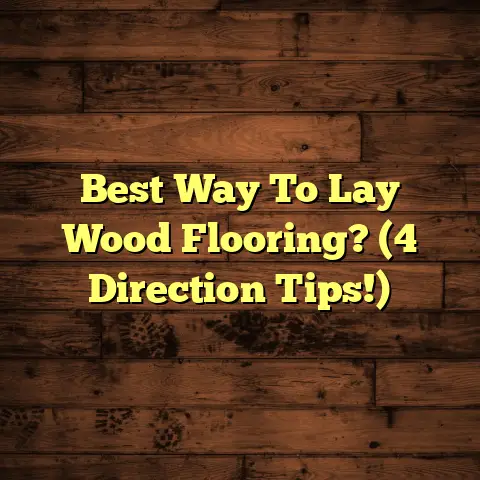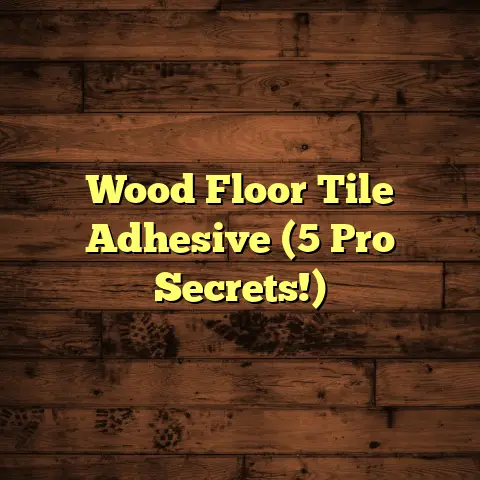Floor Paint For Wood At Screwfix? (2 Options Alert!)
I’m a flooring contractor, and I’ve seen it all when it comes to wooden floors.
Worn-out, scratched, stained, or just plain ugly floors can really bring down the look of a home.
It’s like wearing a great outfit with scuffed-up shoes – it just doesn’t work!
And let’s be honest, nobody wants that.
The good news is that you don’t always have to resort to expensive replacements or time-consuming sanding and refinishing.
Sometimes, a good coat of floor paint can do wonders, breathing new life into your tired old floor.
It’s a cost-effective, practical solution that can transform your space.
But where do you start?
What are the best options out there?
If you’re like many of my clients, you’re probably wondering:
“What are the best floor paint options available for wood at Screwfix?”
Well, you’re in luck!
I’ve done the research, and I’m here to walk you through some fantastic choices you can find at Screwfix.
Let’s dive in!
Section 1: Understanding Floor Paint for Wood
Okay, so what exactly is floor paint?
And how is it different from the regular paint you’d slap on a wall?
Floor paint, especially the kind designed for wood, is formulated to be much tougher than your average paint.
It needs to withstand foot traffic, scuffs, spills, and the general wear and tear that comes with being underfoot.
Think of it as paint on steroids!
Durability is Key
Regular paint is fine for vertical surfaces that don’t get a lot of abuse.
But floor paint is designed to be walked on, scooted across, and even occasionally subjected to dropped objects.
It has to be more resistant to chipping, scratching, and fading.
Adhesion Matters
Floor paint also has superior adhesion properties.
This means it’s designed to stick to the wood surface much better than regular paint, even after repeated use.
This is crucial because you don’t want your paint peeling up after a few months!
Finish Options
Floor paint comes in a variety of finishes, just like regular paint.
You can choose from matte, satin, semi-gloss, or gloss, depending on the look you’re going for.
A higher gloss finish will be more durable and easier to clean, but it will also show imperfections more easily.
A matte finish will hide imperfections better, but it might not be as easy to clean.
Choosing the Right Paint for Your Wood
Not all wood is created equal, and neither is all floor paint.
Hardwood floors like oak, maple, and cherry are dense and durable.
They can handle most types of floor paint, especially those designed for high-traffic areas.
Softwood floors like pine and fir are more porous and prone to denting.
For these floors, you’ll want to choose a paint that’s specifically designed for softwood, or use a good primer to seal the wood before painting.
Engineered wood floors are a bit of a hybrid.
They have a thin layer of hardwood on top of a plywood or MDF core.
You can usually paint them just like hardwood floors, but always check the manufacturer’s recommendations first.
Section 2: The Benefits of Using Floor Paint
So, why choose paint over other flooring options like carpet, laminate, or tile?
Well, there are several compelling reasons:
Cost-Effectiveness
Let’s face it: flooring can be expensive!
Replacing an entire floor can cost thousands of pounds, not to mention the labor involved.
Painting is a much more budget-friendly option.
A few tins of paint, some basic supplies, and a weekend of your time can completely transform a room.
Ease of Application
While it’s not quite as simple as slapping paint on a wall, painting a floor is still a relatively straightforward DIY project.
With the right preparation and tools, most homeowners can achieve professional-looking results without hiring a contractor.
I always encourage my clients to give it a shot.
Aesthetic Improvements
Paint can completely change the look and feel of a room.
You can choose a bold color to make a statement, a neutral shade to create a calming atmosphere, or even create a custom design with stencils or patterns.
The possibilities are endless!
Protective Features
Good floor paint isn’t just about looks.
It also provides a protective layer that can extend the life of your wooden floors.
It can help resist wear and tear, moisture, and staining.
This is especially important in high-traffic areas like hallways and kitchens.
Extending the Life of Your Floors
By protecting your floors from damage, paint can help you avoid costly repairs or replacements down the road.
It’s a preventative measure that can save you money in the long run.
Think of it as a shield for your investment!
Section 3: Overview of Screwfix as a Retailer
Okay, so we know why floor paint is a great option.
But why Screwfix?
Screwfix is a well-known and trusted retailer in the UK, especially among DIY enthusiasts and tradespeople.
They’ve built a reputation for offering a wide range of quality tools, materials, and supplies at competitive prices.
A Go-To for DIYers
Screwfix is like a candy store for DIYers.
They have everything you need for home improvement projects, from power tools to plumbing supplies to, of course, floor paint!
Their website and stores are well-organized and easy to navigate, making it a breeze to find what you’re looking for.
Variety of Flooring Solutions
While Screwfix doesn’t specialize exclusively in flooring, they do offer a decent selection of flooring solutions, including floor paints, varnishes, and sealants.
Their selection of floor paints for wood is particularly noteworthy.
They carry a range of brands and types, so you’re sure to find something that fits your needs and budget.
Customer Service
Screwfix is known for its helpful and knowledgeable staff.
They’re always willing to answer your questions and offer advice on your projects.
They also have a generous return policy, so you can buy with confidence.
Plus, their website is full of customer reviews, which can be a valuable resource when making a purchasing decision.
I always tell my clients to read the reviews before buying anything!
Section 4: Option 1 – High-Performance Floor Paint
Alright, let’s get down to the nitty-gritty.
What specific floor paint options can you find at Screwfix?
The first option I want to highlight is a high-performance floor paint designed specifically for wood.
This type of paint is engineered for maximum durability and longevity.
Key Features
-
Quick Drying Time: Nobody wants to wait forever for their floor to dry. High-performance floor paints often have a quick drying time, allowing you to get back to using your room sooner.
-
Superior Coverage: A little goes a long way with high-performance paint. It typically offers excellent coverage, meaning you’ll need fewer coats to achieve the desired result.
-
High Durability: This is the big one. High-performance floor paint is designed to withstand heavy foot traffic, scuffs, and spills. It’s a great choice for busy households.
Technical Specifications
- Coverage Area: Typically around 10-12 square meters per liter, but always check the manufacturer’s specifications.
- Drying Times: Touch dry in 2-4 hours, re-coatable in 16-24 hours. Again, refer to the product label for accurate drying times.
- Finish Options: Available in matte, satin, semi-gloss, and gloss.
Step-by-Step Guide: Prep & Application
Okay, so you’ve got your high-performance floor paint.
Now what?
Here’s a step-by-step guide to prepping and painting your wooden floor:
- Cleaning: Start by thoroughly cleaning the floor to remove any dirt, dust, grease, or wax. I recommend using a dedicated floor cleaner or a solution of mild soap and water.
- Sanding: Sanding is crucial for creating a smooth surface and ensuring proper adhesion. Use a medium-grit sandpaper (120-150 grit) to lightly sand the entire floor. If your floor has a lot of existing paint or varnish, you may need to start with a coarser grit (80-100 grit).
- Vacuuming: After sanding, vacuum up all the dust and debris. Then, wipe the floor down with a damp cloth to remove any remaining dust.
- Priming (Optional): If your floor is particularly porous or has been previously painted with a different type of paint, you may want to apply a primer. A primer will help seal the wood and create a uniform surface for the paint to adhere to.
- Painting: Now for the fun part! Use a high-quality paintbrush or roller to apply the paint. Start with the edges of the room and then fill in the rest. Apply thin, even coats and allow each coat to dry completely before applying the next. I usually recommend two coats for optimal coverage and durability.
- Curing: Once you’ve applied the final coat, allow the paint to cure completely before walking on the floor. Curing times vary depending on the paint, but it’s usually around 24-72 hours.
Tools You’ll Need
- Floor cleaner
- Sandpaper (various grits)
- Sanding block or pole sander
- Vacuum cleaner
- Damp cloth
- Primer (optional)
- Paintbrush or roller
- Paint tray
- Painter’s tape
- Stir stick
Section 5: Option 2 – Eco-Friendly Floor Paint
For those of you who are environmentally conscious, Screwfix also offers eco-friendly floor paint options.
These paints are formulated with low VOCs (volatile organic compounds) and non-toxic ingredients.
Benefits of Eco-Friendly Paint
- Low VOCs: VOCs are chemicals that can evaporate from paint and contribute to indoor air pollution. Eco-friendly paints have low VOC levels, making them safer for your health and the environment.
- Non-Toxic Formulations: Eco-friendly paints are often made with natural or plant-based ingredients, avoiding harsh chemicals that can be harmful to your health.
- Sustainable Production: Many eco-friendly paint manufacturers are committed to sustainable production practices, such as using recycled materials and reducing waste.
Technical Specifications
- Coverage Area: Similar to high-performance paint, around 10-12 square meters per liter.
- Drying Times: Drying times may be slightly longer than high-performance paint, typically around 4-6 hours to touch dry and 24-48 hours to re-coat.
- Finish Options: Available in matte, satin, and semi-gloss.
- Eco-Friendly Certifications: Look for certifications like the EU Ecolabel or the Blue Angel, which indicate that the paint meets strict environmental standards.
Preparation and Application
The preparation and application steps for eco-friendly floor paint are generally the same as for high-performance paint.
However, there are a few things to keep in mind:
- Read the Label Carefully: Eco-friendly paints may have slightly different application instructions than traditional paints. Be sure to read the label carefully and follow the manufacturer’s recommendations.
- Ventilation: While eco-friendly paints have low VOCs, it’s still important to ventilate the room while painting. Open windows and doors to allow fresh air to circulate.
- Clean-Up: Clean up any spills or drips immediately with a damp cloth. Dispose of leftover paint and cleaning supplies properly, following local regulations.
Handling Differences
One thing I’ve noticed with eco-friendly paints is that they can sometimes be a bit thinner than traditional paints.
This means you may need to apply more coats to achieve the desired coverage.
It’s also important to stir the paint thoroughly before each use to ensure that the pigments are evenly distributed.
Section 6: Comparing the Two Options
Okay, so you’ve got two great options: high-performance floor paint and eco-friendly floor paint.
But which one is right for you?
Here’s a comparison table to help you decide:
| Feature | High-Performance Floor Paint | Eco-Friendly Floor Paint |
|---|---|---|
| Price | Generally more expensive | Generally less expensive |
| Drying Time | Faster | Slower |
| Ease of Application | Easier | Slightly more difficult |
| Durability | Higher | Moderate |
| Environmental Impact | Higher | Lower |
| VOCs | Higher | Lower |
| Finish Options | More | Fewer |
Factors to Consider
- Budget: If you’re on a tight budget, eco-friendly paint is generally the more affordable option.
- Time: If you need to get the job done quickly, high-performance paint has a faster drying time.
- Durability: If you have a high-traffic area or pets, high-performance paint will offer better protection.
- Environmental Concerns: If you’re concerned about the environment and your health, eco-friendly paint is the clear choice.
- Personal Preferences: Ultimately, the best option is the one that best fits your personal preferences and needs.
Which Option is Right for You?
- Choose High-Performance If: You need maximum durability, you’re on a tight schedule, and you’re not overly concerned about the environmental impact.
- Choose Eco-Friendly If: You’re concerned about the environment and your health, you’re on a budget, and you don’t mind waiting a bit longer for the paint to dry.
Section 7: Real-Life Applications and Case Studies
Let’s take a look at some real-life examples of how these floor paint options have been used:
Case Study 1: The Busy Family Home
A family with two young children and a dog used high-performance floor paint to revitalize their hallway.
They chose a semi-gloss finish in a neutral color to hide scuffs and stains.
The paint held up remarkably well to the constant foot traffic and muddy paw prints.
Case Study 2: The Eco-Conscious Apartment
A young couple living in an apartment chose eco-friendly floor paint to update their living room.
They opted for a matte finish in a soft gray color to create a calming and inviting space.
They were pleased with the low VOC levels and the overall look and feel of the paint.
Common Mistakes to Avoid
Based on my experience and feedback from other users, here are some common mistakes to avoid when painting wooden floors:
- Skipping the Prep Work: Proper preparation is essential for achieving a smooth and durable finish. Don’t skip the cleaning, sanding, and priming steps.
- Applying Too Much Paint: Applying thick coats of paint can lead to drips, runs, and uneven drying. Apply thin, even coats and allow each coat to dry completely before applying the next.
- Using the Wrong Tools: Using the wrong paintbrush or roller can result in a poor finish. Invest in high-quality tools designed for painting floors.
- Walking on the Floor Too Soon: Allow the paint to cure completely before walking on the floor. This will prevent scuffs and marks.
Tips for Achieving the Best Results
- Test the Paint: Before painting the entire floor, test the paint in an inconspicuous area to make sure you like the color and finish.
- Use Painter’s Tape: Use painter’s tape to protect baseboards, trim, and other surfaces from paint splatters.
- Stir the Paint Regularly: Stir the paint regularly to keep the pigments evenly distributed.
- Work in Small Sections: Work in small sections to prevent the paint from drying out before you can blend it in.
- Be Patient: Painting a floor takes time and effort. Be patient and don’t rush the process.
Conclusion
So, there you have it!
A comprehensive guide to floor paint for wood at Screwfix.
I hope this article has been helpful in your quest to revitalize your wooden floors.
Remember, painting is a cost-effective and practical solution that can transform your space.
Whether you choose high-performance paint or eco-friendly paint, Screwfix has options to cater to a range of needs and preferences.
Assess your own flooring situation, consider the transformative power of a good floor paint, and get ready to unleash your inner DIYer!
Happy painting!





